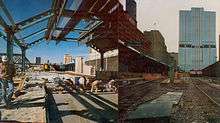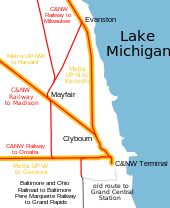Ogilvie Transportation Center
Transportation Center | ||||||||||||||||||||
|---|---|---|---|---|---|---|---|---|---|---|---|---|---|---|---|---|---|---|---|---|
 | ||||||||||||||||||||
| Location |
500 West Madison Street Chicago, Illinois 60661 United States | |||||||||||||||||||
| Coordinates | 41°52′58″N 87°38′25″W / 41.88269°N 87.64029°WCoordinates: 41°52′58″N 87°38′25″W / 41.88269°N 87.64029°W | |||||||||||||||||||
| Owned by | Union Pacific, Metra | |||||||||||||||||||
| Platforms | 8 island platforms | |||||||||||||||||||
| Tracks | 16 | |||||||||||||||||||
| Connections |
Clinton (CTA Green and Pink Lines station) Washington/Wells (CTA station) | |||||||||||||||||||
| Construction | ||||||||||||||||||||
| Disabled access | Yes | |||||||||||||||||||
| Other information | ||||||||||||||||||||
| Fare zone | A | |||||||||||||||||||
| History | ||||||||||||||||||||
| Opened | 1911–1912 | |||||||||||||||||||
| Rebuilt | 1984–1987 | |||||||||||||||||||
| Previous names |
Chicago and North Western Terminal North Western Station | |||||||||||||||||||
| Traffic | ||||||||||||||||||||
| Passengers | 106,700 daily (Metra)[1] | |||||||||||||||||||
| Services | ||||||||||||||||||||
| ||||||||||||||||||||
The Richard B. Ogilvie Transportation Center /ˈoʊɡɪlviː/ is a passenger terminal in downtown Chicago, Illinois, serving the three commuter rail lines of Metra's Union Pacific District, which approach the terminal elevated above street level. It occupies the lower floors of the Citigroup Center. The building occupies two square blocks, bounded by Randolph Street and Madison Street to the north and south and by Canal Street and Clinton Street to the east and west. It is the second busiest rail station in Chicago, after Union Station.
History
The 1911 station

The Chicago and North Western Railway built the Chicago and North Western Terminal in 1911 to replace its Wells Street Station across the North Branch of the Chicago River. The new station, in the Renaissance Revival style, was designed by Frost and Granger, also the architects for the 1903 LaSalle Street Station.[2]
The station's 16 tracks were elevated above street level and "reached by six approach tracks and sheltered under an 894-foot-long [272 meter] Bush train shed."[2] The upper level of the head house housed a concourse and other facilities for intercity passengers, including "dressing rooms, baths, nurses and matrons rooms, and a doctor's office."[3] The centerpiece of the upper level was a stately waiting room, measuring 201 by 202 feet (34 by 62 meters), and rising 84 feet (approx. 26 meters) to its barrel-vaulted ceiling.[2] In addition to the main concourse on the upper level, there was a street-level concourse for commuters.
.jpg)
During the heyday of rail travel, the Chicago and North Western Terminal was home to the C&NW's trains to Milwaukee, Minneapolis-St Paul, Madison and other cities of the upper Midwest, including the railroad's premier "400" series of trains. Until October 30, 1955, it was also the Chicago terminus of the trains the Union Pacific ran in conjunction with the C&NW, including the Overland Limited and the famed "City" trains. See below for some of the best known of the trains served by this station.
The 1984 station
In 1984 the 1911 head house was razed and replaced with the glass-and-steel 42-story Citicorp Center, which was completed three years later in 1987. The station was renamed the Ogilvie Transportation Center in 1997, two years after the C&NW merged into the Union Pacific Railroad. The station was named for Richard B. Ogilvie, a board member of the Milwaukee Road and a lifelong railroad proponent, who, as governor of Illinois, created the RTA, which is the parent agency of Metra.
1991 rehabilitation

In 1991 Metra purchased the train shed from Chicago and North Western and conducted a survey to determine the condition. The examination included necessary repairs to improve its structural integrity and redesign measures to bring the station up to modern mass-commuting standards. After completing a thorough evaluation, Metra, the Urban Mass Transportation Administration, and the Illinois Department of Transportation decided to completely replace the existing structure and in 1992, with the assistance of Federal funding, a contractor and management team were selected to begin the work.
Many engineering challenges had to be addressed and resolved, not only because of the train shed’s prominent location but also due to its high traffic volume as it was to remain operational to 45,000 daily commuters during the project. Such challenges included the removal of original lead paint, the complete replacement of all 16 tracks (serving 200 trains a day), extensive structural steel repairs (under load), erection of a new steel canopy, complete exterior masonry restoration, new electrical and plumbing systems, and construction of a new pedestrian concourse. During the rehabilitation project, which lasted four years and cost $138 million, over 60 contractors spent more than 800,000 man-hours performing repairs and producing new construction.
Platforms and tracks

The station has 16 tracks with eight island platforms, each island platform servicing two tracks. Not all the platforms are the same length; the platforms on the western part of the station (tracks 1-10) are significantly longer than the eastern platforms. In general, West Line trains depart from the western platforms (roughly tracks 1-5), Northwest Line trains depart from the middle tracks (6-11), and North Line trains depart from the eastern tracks (12-16). This is done so that departing and arriving trains do not have to make large switch movements, which would block the use of other tracks and prevent multiple trains from arriving and departing at the same time. Just north of the station, the number of tracks reduces from 16 to six. Switches allow for trains on any of the 16 station tracks to end up on any of these six tracks, and vice versa. About a third of a mile from the station, the six tracks split into two mainlines of four tracks. One mainline turns west, while the other turns northwest. West Line trains take the west tracks, while Northwest and North Line trains take the northwest tracks.
Services

The Chicago and North Western Terminal has served as a terminal for all the commuter and intercity trains of the Chicago and North Western Railway. In addition, on November 9, 1969, the day after Grand Central Station closed, the Baltimore and Ohio Railroad and Pere Marquette Railway, Grand Central's two remaining users, moved their remaining intercity services into the C&NW's terminal. Those trains, which used the C&NW's branch to the St. Charles Air Line west of Western Avenue, last ran on April 30, 1971, the day before Amtrak took over most intercity passenger trains in the U.S. Amtrak services over the lines of those two railroads have run into Union Station.
Metra's three Union Pacific District lines – the Union Pacific/North Line, Union Pacific/Northwest Line and Union Pacific/West Line – now provide regular commuter rail service along three former C&NW lines. In Metra's zone-based fare schedule, Ogilvie is in Zone A. More than 106,000 people board Metra trains at Ogilvie Transportation Center each day.[1]
Bus and 'L' connections
Bus connections can be made on Madison Street or Washington Boulevard via the Citigroup Center or through a lower level concourse accessible by the track platforms between Washington Boulevard and Randolph Street with entrances at Canal and Clinton Streets. Ogilvie is served by the Green and the Pink lines of the CTA's 'L' system, three blocks north of Madison Street on Clinton and Lake Streets; passengers can use the Washington/Randolph concourse exit to walk one and a half blocks to Clinton.
- J14 Jeffery Jump
- 19 United Center Express
- 56 Milwaukee
- 60 Blue Island/26th (Owl Service)
- 120 Ogilvie/Streeterville Express
- 124 Navy Pier
- 125 Water Tower Express
- 126 Jackson
- 128 Soldier Field Express
- 130 Museum Campus
- 157 Streeterville/Taylor
- 192 University of Chicago Hospitals Express
Major trains of the pre-Amtrak era
- Chicago & North Western trains
- North Western Limited
- Twin Cities 400
- Flambeau 400
- Rochester 400
- Kate Shelley 400
- Dakota 400
- Union Pacific/Chicago & North Western trains
- Overland Limited
- City of San Francisco
- City of Los Angeles
- City of Portland
- City of Denver
- Gold Coast
See also
References
- 1 2 https://metrarail.com/content/dam/metra/documents/ridership_reports/Passgr%20Ops%20v4%2020131014.pdf
- 1 2 3 Holland, Kevin J. (2001). Classic American Railroad Terminals. Osceola, WI: MBI. pp. 82–83. ISBN 9780760308325. OCLC 45908903.
- ↑ Maiken, Peter T. (1989). Night Trains. Baltimore, MA: Johns Hopkins University Press. p. 166.
- Kevin P. Keefe, City of Six Stations, Trains July 2003, p. 69
External links
| Wikimedia Commons has media related to Ogilvie Transportation Center. |
- PRR Chronology
- Main entrance (Madison Street) from Google Maps Street View
- Washington Boulevard entrance from Google Maps Street View